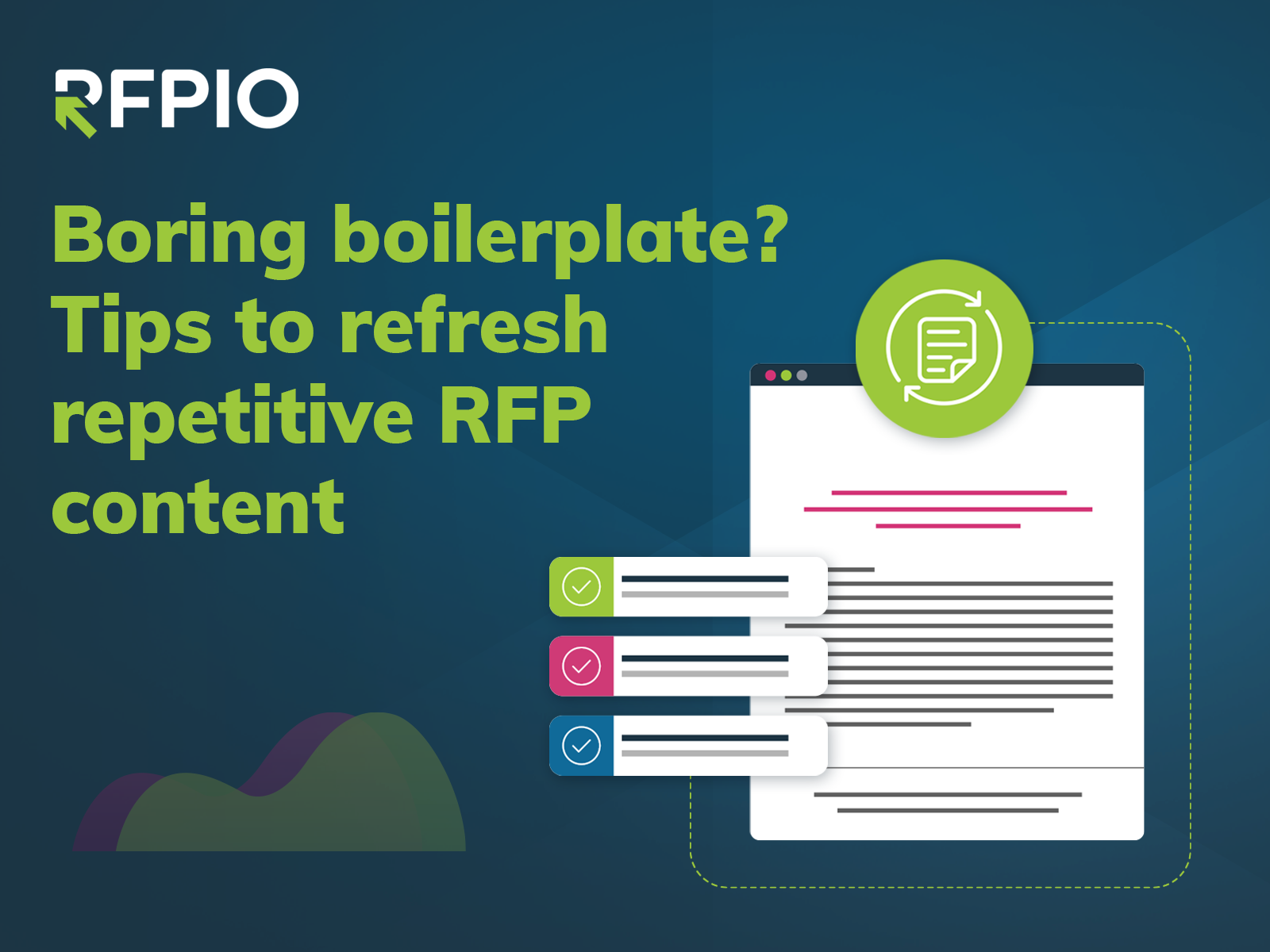If you received a new RFP today that had 100 questions, how many of them would you assume that you’ve already answered? For most bid and proposal managers, the number of repeat questions per RFP is somewhere between 60 and 80 percent. Within that subset, there are questions that you’ve not just answered once before, but dozens of times. These responses are your boilerplate RFP content. And chances are you could recite them verbatim in your sleep.
Using boilerplate content is inevitable when answering RFPs. Because you’ve seen it so many times, the information probably feels basic, low value and low risk. In a word? Boring. But, buyers still have to ask — and you have to answer. So, you might as well make the most of it and optimize. Here’s how.
Review responses regularly
This advice isn’t new or revolutionary, but boilerplate responses don’t tend to get as much attention as content that requires customization. However, it’s important to review the standard answers in your RFP content library at least twice a year to ensure they’re still accurate and effective.
To do this, it can be helpful to ask for feedback from someone outside of the bid and proposals team. Try enlisting a colleague from sales or marketing to bring a fresh perspective to the conversation.
Be relentlessly concise
When it comes time for your buyer to evaluate hundreds of answers back to back, they will appreciate brevity. Unfortunately, after years of use and dozens of editors, boilerplate responses have a tendency to get a little bloated.
When reviewing, consider how you can communicate your core message as concisely as possible. Here are a few tips to keep in mind:
● Break down lengthy answers into short sentences and paragraphs
● Replace overly complex language with clear, direct alternatives
● Remove dependent clauses and prepositional phrases that don’t add value
Enrich short answers with links
While important to gather, the responses to standard questions usually don’t carry a lot of weight in the final RFP score. In this case, consider leveraging links to balance the need to provide plenty of information but also be brief.
For example, most RFPs will ask for information about privacy policies and data security. Rather than burning 300 words or more discussing the details, consider an answer that reassures them that your organization is invested in protecting its customers. You can cover the basics and then refer the reader to a linked document with additional information should they need it.
Listen (aloud) to your responses
When you’ve seen the same answer hundreds of times, it’s easy to glaze over areas that could be improved. Hearing your responses read out loud can help you identify awkward or unclear sentence structure, cumbersome word choices and meandering trains of thought. Shake things up by reading the content out loud to yourself or using a helpful text-to-speech tool.
Embrace scan-friendly formatting
Let’s face it, most of the people who evaluate your proposal aren’t going to read every single word. Consequently, it’s best to format your boilerplate content in a way that makes it easy to scan and understand at a glance.
The key is to keep things simple and organized so that readers can quickly get the information they need. Make good use of headings, subheadings, callouts and bullet points to draw attention to the most important elements of your message.
Make wise word choices
Bid and proposal managers are masters at finding the middle ground between creative, compelling, and candid. Put this skill to good use in your standard responses. Using too many adjectives like amazing, incredible and awesome can quickly erode credibility. Instead focus on meaningful descriptors and avoid fluff.
Similarly, review your boilerplate responses for words that appear over and over again. This is particularly noticeable with buzzwords, corporate speak and cliches. For example, it’s OK to highlight how your solution “improves efficiency,” but it’s probably best to limit usage to no more than three times. After all, any word can lose meaning when overused.
Match your brand persona
Most B2B buyers do 70 percent of their research before they ever reach out. So, by the time you receive an RFP, the prospect is probably already familiar with your brand. Leverage that familiarity in your boilerplate responses and make sure the tone matches your marketing materials. If your website is conversational and approachable, don’t make your RFP response dry and academic.
Prioritize consistency
In addition to matching the tone on your website, be sure to make your standard responses follow a consistent style. When working on large RFP documents and melding feedback from dozens of sources and SMEs, it’s easy to lose track of product capitalization, margins, font, sizing, spacing, kerning and so on. While I don’t have a strong opinion about AP vs Chicago style or the Oxford comma, consistency counts. It would be a shame to let formatting distract the reader from your message.
This is particularly challenging if you use Word or Excel to manually construct your proposals. Alternatively, even if you have an RFP software solution that automates formatting, it’s still important to spot-check your final export.
Final thoughts on boilerplate RFP content
We all know that standard response content isn’t going to win you a Pulitzer prize. However, it does play a key part in highlighting and reinforcing your organization’s attention to detail, commitment to quality and understanding of the buyer’s needs. By leveraging these principles when crafting boilerplate responses for RFPs, you will be able to create an approachable tone that resonates with potential customers and helps win more bids.




Join the Conversation